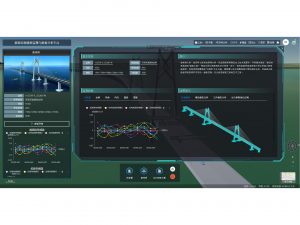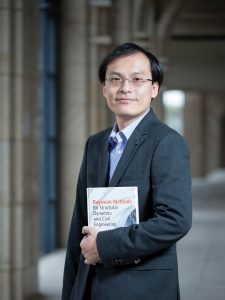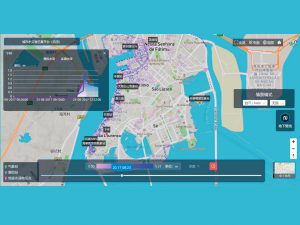As the populations of major cities continue to grow, the challenges facing the maintenance and operation of civil infrastructure have become more and more complex. In particular, the reduction of safety hazards and mitigation of natural disasters are two alarming contemporary issues. In view of this, a research group on public safety and disaster prevention of the University of Macau’s (UM) State Key Laboratory of Internet of Things for Smart City (SKL-IOTSC) studies the marine disaster chain caused by extreme weather events in coastal cities, and strives to build an intelligent maintenance and risk assessment system for monitoring structural health and issuing early warnings, in order to protect the lives of urban residents.
Studying the Marine Disaster Chain in Coastal Cities
Cities in the Guangdong-Hong Kong-Macao Greater Bay Area (GBA) are located on the westward path of typhoons originating in the Western Pacific. During typhoon season, these cities are frequently hit by typhoons and may experience severe urban floods, landslides, and other secondary disasters. With storm surges and geotechnical hazards as the focus, the researchers conduct simulations and risk assessments to study the marine disaster chain caused by extreme weather events in coastal cities.
SKL-IOTSC inaugurated the UM Satellite Ground Station in February 2023. The station can receive data from meteorological satellites and high-definition satellites, which greatly improves the observation accuracy for detecting key elements of disasters as well as regional mobile detection capability. The establishment of the station also marked the deep integration of marine science, the Internet of Things, and remote sensing technology, which can facilitate future studies on topics such as climate change, typhoons and rainstorms, the marine environment, and air pollution in coastal cities.
The group built the Urban Flooding Simulation Platform to collect various data. The data include the results of hydrodynamic processes that simulate storm surge events, information about tide levels and relevant warning signals, the spatiotemporal distribution of surface flood flows, the measurements at each meteorological and hydrological station, as well as the spatiotemporal distribution and depth of flood discharges in the underground pipe network during flood events. These data help researchers better understand the marine disaster chain and improve the integrated capability of coastal cities in disaster response.
Assessing Structural Safety in a Timely Manner
The group is committed to exploring the impact of natural disasters on people, vehicles, and important fundamental facilities in an urban environment. The researchers have conducted many cutting-edge studies on topics such as structural health monitoring, intelligent operations, and intelligent maintenance, with the goal of enhancing the resilience of coastal cities. Many of them have received grants from national or provincial research funds and have achieved fruitful results.
To monitor the health of civil infrastructure, the group has proposed innovative Bayesian methodologies to assess structural safety, predict structural performance changes, and issue early warnings for unexpected events in a timely manner. Yuen Ka Veng, distinguished professor of the Department of Civil and Environmental Engineering, is a long-time researcher of Bayesian analysis and applications. Headed by Prof Yuen, the group has built a Bayesian framework for structural health monitoring, which not only ensures the safe operation of fundamental facilities, but also provides an important theoretical basis and technical support for relevant studies in the field.
Large buildings occasionally experience emergencies, and in the worst-case scenario, face a risk of collapse. ‘We strive to detect structural damage in buildings in the shortest possible time using intelligent algorithms,’ says Prof Yuen. In view of the complexity of the operation of large structures, the researchers proposed a novel Bayesian distributed identification algorithm for structural parameters based on a wireless sensing network. The algorithm can address the problem of non-synchronised data. When a sensor failure occurs, the algorithm can also help to find the faulty sensor to ensure the accuracy of data analysis. These results have been published in a Springer monograph.
3D Intelligent Operation and Maintenance
It is challenging to ensure the safe operation of sea-crossing infrastructure considering the complex conditions in a coastal environment and the risk of natural disasters. To reduce their combined effect, the researchers have been studying intelligent algorithms and assessments for sea-crossing infrastructure. In 2019, SKL-IOTSC began working with the Hong Kong-Zhuhai-Macao Bridge (HZMB) Authority and other units to promote the intelligent operation, monitoring, and maintenance of the bridge with cutting-edge technologies. Two such projects are under the National Key Research and Development Programme and the Guangdong Provincial Key Research and Development Programme, respectively. The national-level project focuses on the applications of smart technologies in the operation and maintenance of HZMB, while the provincial-level project investigates intelligent safety monitoring and emergency control for sea-crossing projects.
Focusing on these weak connecting parts and the deformable connecting parts between the immersed tubes, the researchers designed a 3D deformation sensing system for the bridge based on fibre grating technology. Combining technologies such as physical modelling, edge computing, wireless network transmission, and intelligent algorithms with big data, the system can effectively predict and assess the health of different parts of the bridge. Zhou Wanhuan, head of the Department of Civil and Environmental Engineering and professor in SKL-IOTSC, is the lead researcher of the project. ‘Our 3D deformation sensing system is based on fibre grating technology. It can monitor the immersed tube over an extended period of time and detect signs of deformation in real-time to ensure that necessary maintenance measures are taken promptly,’ Prof Zhou says.
Monitoring the Health of Sea-crossing Infrastructure in the GBA
The research group takes advantage of theoretical developments in Bayesian system identification, stochastic model updating, and probabilistic machine learning. Through the platform, the researchers analyse data from the environment, wind load data, and dynamic responses to monitor the health of structures such as the Qingzhou Channel Bridge, the Second Hengqin Bridge, and the N21 Research Building at UM. The platform can achieve intelligent analysis on massive environmental data and load data, and demonstrates research results such as the finite element model of the benchmark structure, as well as the extraction and prediction of key health indicators.
Urban resilience is a prerequisite for risk prevention and control in a city. The numerous existing and ongoing large-scale infrastructure projects in the GBA, including sea-crossing bridges, underwater tunnels, and high-rise structures, all face challenges brought by long-term maintenance and safe operation. They will also affect the integrated development of coastal cities in the region. ‘Using intelligent and automated means, we are able to locate damage and evaluate the severity as early as possible in order to buy time to reinforce the structure,’ says Prof Yuen. ‘We will continue to accumulate practical experience in disaster prevention and mitigation in coastal cities and structural health monitoring, in order to further improve the urban public safety system.’
Text / Kelvin U, Trainee UM Reporter Zhang Jiahe
Photo / Jack Ho, with some provided by the interviewees
English Translation / Anthony Sou
Source: UMagazine ISSUE 27




